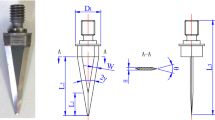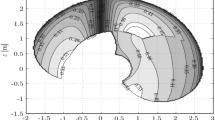Abstract
Due to the notable advantages of ultrasonic-assisted machining, this technology is being more and more adopted in different manufacturing processes. Aramid honeycomb structures are among materials for which ultrasonic-assisted machining has become an interesting alternative thanks to its effect in reduction of machining forces and less micro imperfections. A considerable number of research works have addressed micro machining defeats in ultrasonic application such as dust generation and fiber delamination in Aramid honeycomb workpieces. However, in this study, a great attention is dedicated to the geometrical errors observed in the workpieces in cutting process of Aramid honeycomb structures using ultrasonic technology. The effect of different elements involved in robotic-based ultrasonic-assisted cutting process of Aramid honeycomb structures on these error types has been studied. To proceed this goal, a machining force estimation model is experimentally developed using the machining forces captured during the execution of several cutting tests. An on-site measurement process for measuring the geometrical errors in resulted workpieces is presented. The compliance behavior of robot-tool system is simulated using an extended virtual joint method (VJM) approach. In this approach, the machining tool is considered an additional joint-link system attached to the 6-revolute joint industrial system. Simulation results based on this method applied on the case study showed that the portion of contribution of industrial robotic arm to the compliant errors of process is negligible compared with the one of ultrasonic cutting knife. An offline compensation algorithm is proposed based on the developed machining force and tool compliance behavior models. Experimental results supported the efficiency of the proposed compensation method in reducing the geometrical error by up to 95% based on the machining features.
























Similar content being viewed by others
References
Gill DD, Yip-Hoi DM, Meaker M, Boni T, Eggeman EL, Brennan AM, Anderson A (2017) Studying the mechanisms of high rates of tool wear in the machining of aramid honeycomb composites. In: ASME 2017 12th International Manufacturing Science and Engineering Conference collocated with the JSME/ASME 2017 6th International Conference on Materials and Processing, American Society of Mechanical Engineers, pp V002T03A002–V002T03A002
Gibson LJ, Ashby MF (1999) Cellular solids: structure and properties. Cambridge University Press
Norris CB (1947) An analysis of the compressive strength of honeycomb cores for sandwich construction. FOREST PRODUCTS LAB MADISON WI
Abrate S, Castanié B, Rajapakse YD (2012) Dynamic failure of composite and sandwich structures, vol 192. Springer Science & Business Media
Mora R, Waas AM (2000) Measurement of the Cosserat constant of circular-cell polycarbonate honeycomb. Philosophical Magazine A 80(7):1699–1713
Seemann R, Krause D (2017) Numerical modelling of nomex honeycomb sandwich cores at meso-scale level. Compos Struct 159:702–718
Seemann R, Krause D (2014) Numerical modelling of nomex honeycomb cores for detailed analyses of sandwich panel joints. In: 11th World Congress on Computational Mechanics (WCCM XI)
Jaafar M, Atlati S, Makich H, Nouari M, Moufki A, Julliere B (2017) A 3d fe modeling of machining process of nomex®; honeycomb core: influence of the cell structure behaviour and specific tool geometry. Procedia CIRP 58:505–510
Xiang DH, Wu BF, Yao YL, Zhao B, Tang JY (2019) Ultrasonic vibration assisted cutting of nomex honeycomb core materials. Int J Precis Eng Manuf 20(1):27–36
Farahnakian M, Razfar MR (2014) Experimental study on hybrid ultrasonic and plasma aided turning of hardened steel aisi 4140. Mater Manuf Process 29(5):550–556
Gürgen S, Çakır FH, Sofuoǥlu MA, Orak S, Kuşhan MC, Li H (2019) Multi-criteria decision-making analysis of different non-traditional machining operations of Ti6l4V. Soft Comput 23 (13):5259–5272
Sofuoğlu MA, Çakır FH, Kuşhan MC, Orak S (2019) Optimization of different non-traditional turning processes using soft computing methods. Soft Comput 23(13):5213–5231
Kang D, Zou P, Wu H, Duan J, Wang W (2019) Study on ultrasonic vibration–assisted cutting of nomex honeycomb cores. Int J Adv Manuf Technol 104(1-4):979–992
Xiang D, Wu B, Yao Y, Liu Z, Feng H (2019) Ultrasonic longitudinal-torsional vibration-assisted cutting of nomex®; honeycomb-core composites. Int J Adv Manuf Technol 100(5-8):1521–1530
Hu XP, Chen SY, Zhang ZC (2012) Research on curved surface forming of nomex honeycomb material based on ultrasonic NC cutting. In: Advanced Materials Research, trans tech publ, vol 538, pp 1377–1381
Verl A, Valente A, Melkote S, Brecher C, Ozturk E, Tunc LT (2019) Robots in machining. CIRP Ann 68(2):799–822
Slamani M, Chatelain JF (2019) Assessment of the suitability of industrial robots for the machining of carbon-fiber reinforced polymers (CFRPS). J Manuf Process 37:177–195
Kim SH, Nam E, Ha TI, Hwang SH, Lee JH, Park SH, Min BK (2019) Robotic machining: a review of recent progress. Int J Precis Eng Manuf, pp 1–14
Bu Y, Liao W, Tian W, Zhang J, Zhang L (2017) Stiffness analysis and optimization in robotic drilling application. Precis Eng 49:388–400
Cunningham P, White R, Aglietti G (2000) The effects of various design parameters on the free vibration of doubly curved composite sandwich panels. J Sound Vib 230(3):617–648
Soovere J (1986) Random vibration analysis of stiffened honeycomb panels with beveled edges. Journal of Aircraft 23(6):537–544
Qin Y, Kang R, Dong Z, Wang Y, Yang J, Zhu X (2018) Burr removal from measurement data of honeycomb core surface based on dimensionality reduction and regression analysis. Measure Sci Technol 29(11):115010
Hu X, Yu B, Li X, Chen N (2017) Research on cutting force model of triangular blade for ultrasonic assisted cutting honeycomb composites. Procedia CIRP 66:159–163
Alblalaihid K, Kinnell P, Lawes S (2015) Fabrication and characterisation of a novel smart suspension for micro-CMM probes. Sensors and Actuators A: Physical 232:368–375
Neamţu C, Hurgoiu D, Popescu S, Dragomir M (2012) Training in coordinate measurement using 3d virtual instruments. Measurement 45(10):2346–2358
Klimchik A, Chablat D, Pashkevich A (2014) Stiffness modeling for perfect and non-perfect parallel manipulators under internal and external loadings. Mech Mach Theory 79:1–28
Salisbury JK (1980) Active stiffness control of a manipulator in Cartesian coordinates. In: 1980 19th IEEE Conference on Decision and Control including the Symposium on Adaptive Processes, vol 19. IEEE, pp 95–100
Du L, Zhang T, Dai X (2019) Compliance error calibration for robot based on statistical properties of single joint. J Mech Sci Technol 33(4):1861–1868
Theissen NA, Laspas T, Archenti A (2019) Closed-force-loop elastostatic calibration of serial articulated robots. Robot Comput Integr Manuf 57:86–91
Chen C, Peng F, Yan R, Li Y, Wei D, Fan Z, Tang X, Zhu Z (2019) Stiffness performance index based posture and feed orientation optimization in robotic milling process. Robotics and Computer-Integrated Manufacturing 55:29–40
Caro S, Dumas C, Garnier S, Furet B (2013) Workpiece placement optimization for machining operations with a KUKA KR270-2 robot. In: 2013 IEEE International Conference on Robotics and Automation, IEEE, pp 2921–2926
Alici G, Shirinzadeh B (2005) Enhanced stiffness modeling, identification and characterization for robot manipulators. IEEE Trans Robot 21(4):554–564
Khalil W, Dombre E (2004) Modeling, identification and control of robots. Butterworth-Heinemann
Huynh HN (2019) Robotic machining: development and validation of a numerical model of robotic milling in order to optimise the cutting parameters, PhD thesis, University of Mons
Acknowledgments
Authors would like to thank the research and development team of Le Creno Industriel company, the industrial partner of this research project.
Funding
The research leading to these results has received funding from FUI Project AAP 22 (ACROBOT) grant.
Author information
Authors and Affiliations
Corresponding author
Ethics declarations
Conflict of interest
The authors declare that they have no conflict of interest.
Additional information
Publisher’s note
Springer Nature remains neutral with regard to jurisdictional claims in published maps and institutional affiliations.
Appendix: A computation of constants Fs, Fc and F0
Appendix: A computation of constants Fs, Fc and F0
To obtain a force predictive model, machining forces for 5 different chamfering angles (40:10:80) are registered in the sensor frame and further converted into the tool frame. Tables 4 and 5 summarize maximum values of each component as a function of chamfering angle in Kistler sensor and cutting tool frames respectively.
To be able to predict the cutting forces in chamfering process of this honeycomb structure, the mathematical expression introduced in Eq. 1 is used. To find the constant values \(F_{s_{i}}\), \(F_{c_{i}}\) and \(F_{0_{i}}\), where subscript i represents any arbitrary component defined in either coordinate systems, an error function Ei is introduced which evaluates the summation of squared errors of force prediction:
Where N is the number of data sets and \(f_{j_{\exp }}\) is the j th experimental force value defined in Tables 4 and 5. To solve for concerned constants using least square method, the derivative of the error function with respect to each constant is equated to zero:
Where operator Σ has replaced \({\Sigma }_{j=1}^{N}\) to sake brevity. The set of equations expressed in Eq. 27 is then converted to the following final matrix notation:
Equation 28 is used to obtain the 6 sets of (Fs, Fc, F0) corresponding to the 3 principal directions of the two mentioned coordinate systems (Tables 1 and 2).
Rights and permissions
About this article
Cite this article
Vakilinejad, M., Olabi, A., Gibaru, O. et al. Geometrical error improvement of Aramid honeycomb workpieces in robot-based triangular knife ultrasonic cutting process. Int J Adv Manuf Technol 110, 523–541 (2020). https://doi.org/10.1007/s00170-020-05855-0
Received:
Accepted:
Published:
Issue Date:
DOI: https://doi.org/10.1007/s00170-020-05855-0




